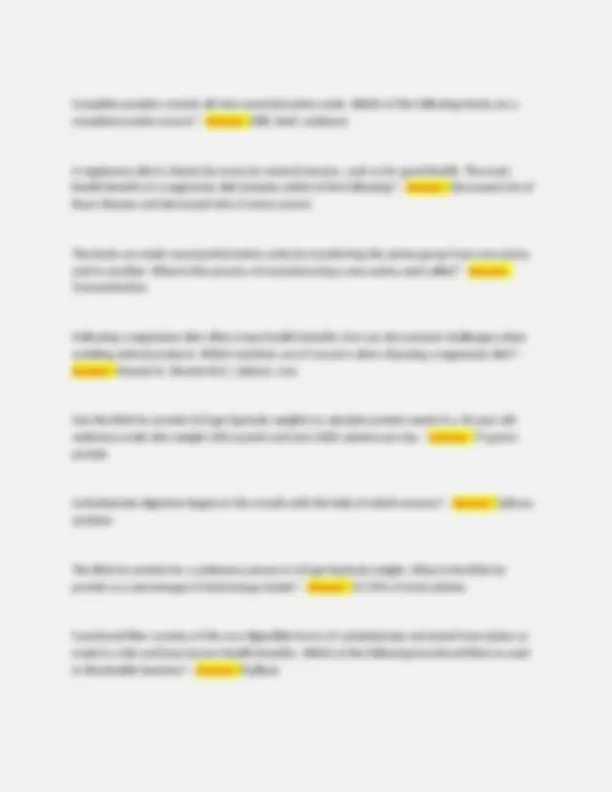





Study with the several resources on Docsity

Earn points by helping other students or get them with a premium plan


Prepare for your exams
Study with the several resources on Docsity

Earn points to download
Earn points by helping other students or get them with a premium plan
Community
Ask the community for help and clear up your study doubts
Discover the best universities in your country according to Docsity users
Free resources
Download our free guides on studying techniques, anxiety management strategies, and thesis advice from Docsity tutors
A series of questions and answers related to human nutrition, focusing on macronutrients like carbohydrates, lipids, and proteins. it covers topics such as carbohydrate metabolism, lipid classification and functions, protein synthesis and digestion, and the role of these nutrients in health and disease. The q&a format allows for a comprehensive review of key concepts in nutrition, making it a valuable resource for students studying human biology, dietetics, or related fields. the questions delve into specific metabolic processes and dietary recommendations, promoting a deeper understanding of nutritional science.
Typology: Exams
1 / 7

This page cannot be seen from the preview
Don't miss anything!




If a Nutrition Facts label lists total carbohydrate as 10 grams and sugar as 5 grams, then how many calories do you get from carbohydrates? - Answer: 40 calories Approximately 90-95% of all cases of Diabetes are classified as type 2. What is the most common trigger for type 2 Diabetes? - Answer: Obesity Plants store glucose as polysaccharides. Which of the following is the storage form of glucose in plants? - Answer: Starch Fiber (especially soluble fiber) offers many health benefits to our body, including helping to decrease the risk of heart disease. What is the recommended amount of fiber we need in our diet daily? - Answer: 14 grams per 1000 calories Food lipids can be distinguished according to their chemical structure. About 95% of the fat in the typical American diet is in the form of a food lipid, composed of a glycerol molecule and three fatty acids. What is the name of this lipid? - Answer: Triglycerides Fish oil, leafy green vegetables and canola oil are all examples of which of the following? - Answer: Alpha linolenic acid This lipid is found in a limited number of foods. It consists of a glycerol backbone with two fatty acids and a compound that contains phosphate. - Answer: Phospholipid Trans fats are made by a process of adding hydrogen atoms to an unsaturated fatty acid, making them more saturated. What is this process called? - Answer: Hydrogenation
Fats (lipids) are a part of every cell membrane and have many functions. One function is that fat is needed for the transport of which nutrients? - Answer: Fat-soluble vitamins (A, D, E, K) A Nutrition Facts label lists total fat as 10 grams and saturated fat as 4 grams. How many calories does fat provide? - Answer: 90 calories Monosaccharides consist of a single sugar molecule. Which of the following are monosaccharides? - Answer: Glucose, fructose, galactose Research has shown that a diet high in this fat, along with trans fats, can increase the risk of cardiovascular disease. - Answer: Saturated fat Lipoproteins play a major role in cardiovascular disease due to the proportion of lipid to protein. Which lipoprotein is also referred to as "bad cholesterol"? - Answer: LDL (low density lipoprotein) Most dietary fat is absorbed in the enterocytes with the help of micelles. In what organ does this occur? - Answer: Small intestine Which lifestyle choice can best help prevent or control cardiovascular disease (heart disease)? - Answer: Decrease saturated fat intake to less than 7% of total calories Essential fatty acids must be consumed in the diet because they cannot be made by our bodies. Which of the following are essential fatty acids? - Answer: Omega-3 and omega-6 fatty acids The gallbladder stores and releases bile that helps in the digestion of fats. Which organ produces bile? - Answer: Liver
Complete proteins contain all nine essential amino acids. Which of the following foods are a complete protein source? - Answer: Milk, beef, soybeans A vegetarian diet is chosen by many for several reasons, such as for good health. The main health benefit of a vegetarian diet includes which of the following? - Answer: Decreased risk of heart disease and decreased risk of some cancers The body can make nonessential amino acids by transferring the amine group from one amino acid to another. What is this process of manufacturing a new amino acid called? - Answer: Transamination Following a vegetarian diet offers many health benefits, but can also present challenges when avoiding animal products. Which nutrients are of concern when choosing a vegetarian diet? - Answer: Vitamin D, Vitamin B12, Calcium, Iron Use the RDA for protein (0.8 gm/kg body weight) to calculate protein needs in a 40 year old sedentary male who weighs 200 pounds and eats 2400 calories per day. - Answer: 73 grams protein Carbohydrate digestion begins in the mouth with the help of which enzyme? - Answer: Salivary amylase The RDA for protein for a sedentary person is 0.8 gm/kg body weight. What is the RDA for protein as a percentage of total energy intake? - Answer: 10-35% of total calories Functional fiber consists of the non digestible forms of carbohydrates extracted from plants or made in a lab and have known health benefits. Which of the following functional fibers is used in dissolvable laxatives? - Answer: Psyllium
Nitrogen balance is a highly specialized procedure used to determine protein needs. It is the relationship between the amount of nitrogen (protein) we consume and the amount we excrete each day. At which stage is a positive nitrogen balance indicated? - Answer: Pregnancy Protein energy malnutrition is caused by poor consumption of protein. Marasmus and Kwashiorkor are two forms of protein energy malnutrition. Which of the following is NOT a characteristic of Kwashiorkor? - Answer: Fluid and electrolyte imbalance Protein digestibility affects protein quality. Which of the following protein sources is highly digestible, meaning our bodies absorb more than 90% of the amino acids? - Answer: Chicken If the recommended percentage of energy from protein is 10-35%, which of the following protein amounts meets the recommendation when following a 2200 calorie diet? - Answer: 24- 86 gm protein If a person exercises regularly, they will most likely have fat stored in muscle tissue so as to have readily available energy when needed. What is the primary storage site for fat in all others? - Answer: Adipose tissue It is recommended that sugar be less than half of the total carbohydrate in a food. The 2015- 2020 Dietary Guidelines for Americans recommends that less than 10% of total energy come from added sugars. What is the most common source of added sugar in the typical American diet? - Answer: Sodas It is recommended that added sugar be less than 10% of total energy. A Nutrition Facts label lists the following: Total carbohydrate 28 gm Fiber 3 gm
Which of the following foods provides adequate amounts of the preferred fuel for the brain? - Answer: Oil Which statement about insulin and glucagon, hormones that regulate glucose levels in the blood, is true? - Answer: Insulin is secreted by the alpha cells of the pancreas and glucagon is secreted by the beta cells of the pancreas. Which of the following conditions results from a diet that is too low in carbohydrate to supply enough glucose to the brain, therefore producing an alternative fuel? - Answer: Ketosis Diabetes is on the rise in the United States and worldwide. Which type of Diabetes results from the body's inability to produce enough insulin and is classified as an autoimmune disease? - Answer: Type 1